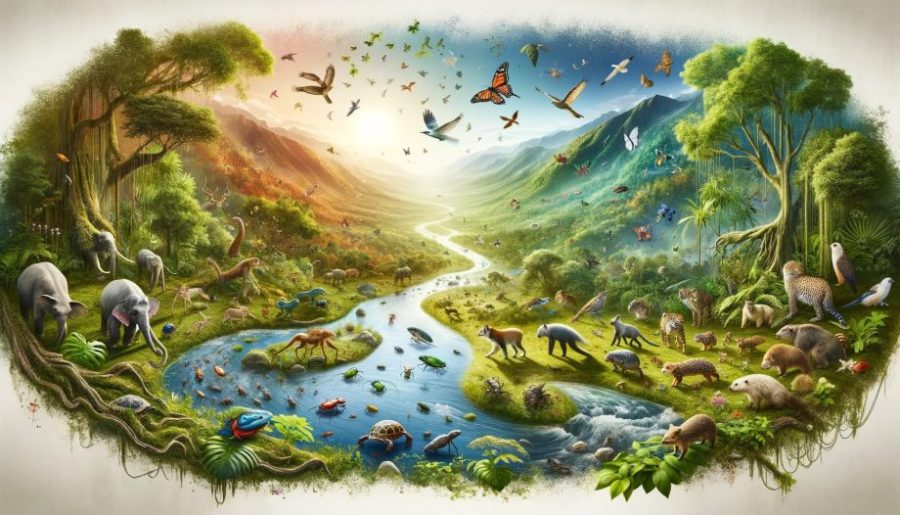
Explore the vital role of enhancing biodiversity through nature-based solutions. Dive into innovative strategies for a sustainable, biodiverse future!
Enhancing Biodiversity Key Takeaways:
- Enhancing biodiversity through nature-based solutions involves using natural processes to restore and maintain diverse ecosystems.
- This approach includes reforestation, wetland restoration, and urban green spaces, crucial for improving species richness, ecosystem health, and resilience against environmental challenges.
Welcome to the green journey of enhancing biodiversity through nature-based solutions!
In this exciting exploration, we’ll uncover how harnessing the power of nature can rejuvenate our planet, bringing a burst of life to ecosystems and communities.
Join us as we delve into the world where nature’s wisdom leads the way to a more vibrant and sustainable tomorrow.
Introduction to Enhancing Biodiversity Through NbS
Biodiversity, the vast array of life on our planet, forms the backbone of ecosystems that sustain life.
Its enhancement is crucial for maintaining ecological balance and ensuring the resilience of these systems.
Nature-based solutions (NbS) are innovative strategies that use natural processes to tackle environmental challenges.
They play a pivotal role in enhancing biodiversity. NbS can range from restoring forests and wetlands to implementing green infrastructure in urban areas.
These solutions are vital for preserving ecosystem services, such as clean air and water, which are essential for human health and well-being.
By understanding and applying NbS, we can make significant strides in reversing biodiversity loss and building a sustainable future.
Biodiversity: A Cornerstone of Life
Biodiversity, encompassing the diversity of life on Earth, is fundamental to the health of our planet.
It ensures the functioning of ecosystems, providing essential services like clean air, water, and fertile soil. Preserving and enhancing biodiversity is critical to maintaining the balance and resilience of these ecosystems.
Nature-Based Solutions: A Path to Biodiversity Enhancement
Nature-based solutions (NbS) represent a holistic approach to environmental challenges.
By leveraging natural processes, NbS aims to protect, sustainably manage, and restore ecosystems.
They are key in addressing biodiversity loss, offering benefits like improved water quality, climate change mitigation, and supporting the well-being of local communities and indigenous peoples.
The Relevance of NbS to Biodiversity
NbS are particularly effective in urban areas and agricultural landscapes.
They involve sustainable practices like creating urban forests, restoring wetlands, and practicing sustainable agriculture.
These solutions not only enhance biodiversity but also contribute to human health, food security, and the sustainable management of natural resources.
Given the importance of these topics, the blog post will delve deeper into how NbS can be effectively implemented to maximize biodiversity benefits, while also considering the challenges and potential solutions.
Understanding Nature-Based Solutions

Nature-based solutions (NbS) are vital strategies for sustainable environmental management.
Defined by the International Union for Conservation of Nature (IUCN), NbS utilizes natural processes to address environmental and societal challenges.
This approach offers a path to combat global issues like climate change, biodiversity loss, and water security, providing benefits for ecosystems and communities alike.
This section delves into the definition, scope, and crucial role of NbS in today’s world.
Defining Nature-Based Solutions
Nature-based solutions (NbS) are grounded in the concept of working with nature to address various societal and environmental challenges.
Defined by the International Union for Conservation of Nature (IUCN), NbS involves practices that protect, sustainably manage, and restore natural or modified ecosystems.
These solutions are carefully designed to provide significant environmental, social, and economic benefits.
NbS ranges from restoring forests and wetlands to integrating green infrastructure in urban settings, each playing a role in enhancing ecosystem services like clean water and air.
The Role of NbS in Tackling Societal and Environmental Challenges
NbS are not just about conservation; they are also about smart, sustainable management of our natural resources.
These solutions address critical challenges such as climate change, biodiversity loss, water security, and food production.
By leveraging the natural world’s inherent abilities, NbS can reduce greenhouse gas emissions, improve urban resilience, and enhance biological diversity.
They offer a way to tackle global warming while also supporting economic growth and social cohesion.
This approach aligns with the Sustainable Development Goals, emphasizing the need for sustainable forest management, conservation of marine ecosystems, and the protection of terrestrial environments.
Table- Understanding Nature-Based Solutions
| Type of NbS | Environmental Benefit | Societal Benefit |
|---|---|---|
| Reforestation | Increases carbon sequestration | Improves air quality |
| Green Infrastructure | Reduces urban heat island effect | Enhances urban living spaces |
| Wetland Restoration | Enhances water purification | Reduces flood risks |
| Sustainable Agriculture | Promotes soil health | Increases food security |
| Coastal Management | Protects against erosion | Supports fisheries and recreation |
In a Nutshell:
In summary, NbS presents a comprehensive approach to addressing environmental challenges, emphasizing the importance of maintaining and enhancing ecosystem health for the benefit of all.
The next sections of the blog will explore the specific impacts of NbS on biodiversity, the challenges in their implementation, and the global trends shaping their future.
The Role of Biodiversity in Ecosystem Services

Biodiversity, the variety of life on Earth, plays a critical role in providing ecosystem services that are essential for human survival and well-being.
This section highlights how diverse species contribute to the health and stability of ecosystems through various ecosystem services.
Pollination and Biodiversity
-
- Pollination, largely carried out by insects, birds, and bats, is crucial for the reproduction of many plants, including those important for agriculture and natural ecosystems. A diverse range of pollinators ensures the continuation of plant species and contributes to genetic diversity.
Water Purification and Ecosystem Health
-
- Biodiverse ecosystems, particularly wetlands, play a significant role in purifying water. Plants, microorganisms, and natural landscapes filter pollutants, thereby maintaining the quality of water resources essential for human consumption, agriculture, and wildlife.
Disease Control Through Biodiversity
-
- A variety of species in an ecosystem can regulate disease vectors, such as mosquitoes. Predators and competitors can keep potential disease carriers in check, reducing the risk of diseases spreading to humans and other animals.
Soil Fertility and Biodiversity
-
- Diverse soil organisms, from bacteria to earthworms, contribute to soil fertility. They are involved in nutrient cycling, decomposition of organic matter, and improving soil structure, which are vital for plant growth and agricultural productivity.
Biodiversity’s Role in Climate Regulation
-
- Ecosystems with rich biodiversity, like forests and oceans, play a key role in regulating the Earth’s climate. They act as carbon sinks, absorbing and storing carbon dioxide, which helps mitigate climate change.
Cultural and Recreational Benefits
-
- Biodiversity also provides cultural and recreational benefits. Natural landscapes and wildlife are central to many cultural identities and offer opportunities for recreation and tourism, contributing to human well-being and economies.
Biodiversity’s role in ecosystem services is vast and multifaceted. Its preservation is not only crucial for ecological reasons but also for the continued provision of these services, which are fundamental to human life and the health of our planet.
The Impact of NbS on Biodiversity
Biodiversity Boost through Nature-Based Solutions
Enhancing biodiversity is a major goal of Nature-Based Solutions (NbS).
These strategies, ranging from restoring natural habitats to introducing green spaces in urban environments, play a critical role in reversing the trend of biodiversity loss.
This section examines how NbS, as studied by organizations like the International Institute for Sustainable Development (IISD) and Frontiers, supports the proliferation of various species and the overall health of ecosystems.
Biodiversity Enhancement through NbS: Insights from Research
-
- Studies by IISD highlight that NbS can significantly improve biodiversity by restoring natural habitats and ecosystems. For example, reforestation projects not only increase tree cover but also provide a habitat for diverse wildlife, contributing to overall ecosystem health.
-
- Research from Frontiers indicates that NbS can lead to positive outcomes like increased species richness, particularly in areas where native habitats have been restored or protected.
Success Stories in NbS Implementation
-
- A notable example of NbS’s success is the restoration of mangrove forests in tropical regions. These projects have not only enhanced marine biodiversity but also provided natural barriers against coastal erosion and improved local fisheries.
-
- Urban green space initiatives, such as the creation of city parks and green corridors, have been shown to increase urban biodiversity, providing habitats for various bird species, insects, and local flora, thus improving urban ecological networks.
Table for The Impact of NbS on Biodiversity
| Nature-Based Solution | Biodiversity Impact | Case Study Reference |
|---|---|---|
| Mangrove Restoration | Enhances marine and coastal biodiversity | Example: Mangrove project in Vietnam |
| Urban Parks | Increases urban wildlife habitats | Example: Central Park, New York City |
| Native Tree Planting | Supports diverse forest ecosystems | Example: Reforestation in Costa Rica |
| Grassland Conservation | Preserves habitats for native species | Example: Prairie preservation in the Midwest, USA |
In a Nutshell:
These examples and research findings illustrate the tangible impacts of NbS on biodiversity.
They show that practical implementation of NbS can lead to significant improvements in both local and global biodiversity, offering a hopeful path forward for conservation efforts.
Challenges and Misconceptions in NbS
Overcoming Obstacles in Nature-Based Solutions
While Nature-Based Solutions (NbS) are powerful tools for environmental sustainability, they also face challenges and common misconceptions.
Addressing these effectively is key to the success of NbS initiatives.
This section, drawing from insights from the International Union for Conservation of Nature (IUCN) and Carbon Brief, discusses the critical aspects of understanding and correctly implementing NbS.
Misunderstandings and Misuse of NbS: Insights from IUCN
-
- The IUCN highlights that NbS are sometimes misunderstood as simple, one-size-fits-all solutions. However, NbS requires careful planning and understanding of local ecosystems.
- Misapplications, such as inappropriate tree planting or mismanaged natural area restoration, can lead to negative impacts on biodiversity and ecosystem services.
-
- Another challenge is distinguishing NbS from traditional conservation methods.
- NbS focuses on integrating ecosystem services into broader societal goals, which requires a nuanced approach to both conservation and development.
Effective Implementation and Avoiding Greenwashing: Lessons from Carbon Brief
-
- According to Carbon Brief, a major challenge in implementing NbS is avoiding greenwashing – where projects are portrayed as environmentally friendly but have little real impact on sustainability. This emphasizes the need for transparent, evidence-based approaches in NbS projects.
-
- Effective implementation also involves engaging local communities and respecting indigenous knowledge. Projects should be tailored to local conditions, ensuring that they contribute to both environmental and social objectives, rather than being driven solely by external interests or short-term economic gains.
In a Nutshell:
Understanding and addressing these challenges is crucial for the success of NbS.
By acknowledging and learning from these hurdles, policymakers, practitioners, and communities can better harness the potential of NbS for environmental and societal benefits.
NbS and Climate Change Adaptation
NbS: A Key Player in Climate Strategy
Nature-Based Solutions (NbS) are increasingly recognized as essential in the fight against climate change.
Not only do they help in mitigating climate impacts, but they also play a significant role in adaptation strategies.
This section, drawing from Knowledge for Policy, explores how NbS contributes to climate change mitigation and adaptation, and the interrelation between biodiversity, NbS, and climate resilience.
NbS in Mitigating and Adapting to Climate Change
-
- NbS, such as restoring forests and wetlands, play a dual role in both mitigating climate change and adapting to its impacts. These solutions help in carbon sequestration, reducing greenhouse gas emissions, and simultaneously enhance the resilience of ecosystems and human communities to climate-related changes and disasters.
-
- For instance, mangrove restoration not only captures significant amounts of carbon but also provides crucial protection against storm surges and sea-level rise, demonstrating the multifaceted role of NbS in climate strategies.
Interconnection Between Biodiversity, NbS, and Climate Resilience
-
- The relationship between biodiversity, NbS, and climate resilience is intricate. Healthy, biodiverse ecosystems are more resilient to the impacts of climate change, making biodiversity conservation a key component of climate adaptation strategies.
-
- NbS also contributes to climate resilience by maintaining ecosystem services such as water regulation, soil stabilization, and providing resources for food security. These services are vital for human societies, especially in the face of increasing climate variability and extreme weather events.
Table for NbS and Climate Change Adaptation
| Nature-Based Solution | Climate Mitigation Benefit | Climate Adaptation Benefit |
|---|---|---|
| Forest Preservation | Carbon storage | Temperature regulation, habitat stability |
| Coral Reef Protection | Carbonate storage | Coastal protection, fishery support |
| Urban Green Spaces | Reduces greenhouse gas emissions | Heat reduction, stormwater management |
| Agroforestry | Increases farm-level carbon sequestration | Drought resilience, soil conservation |
In a Nutshell:
Through these aspects, it becomes evident that NbS are not just beneficial for biodiversity and ecosystems but are also crucial components in comprehensive climate change strategies.
Their role in both mitigation and adaptation underscores the need for integrated approaches to address the global challenges of climate change and biodiversity loss.
The Role of Communities and Indigenous Knowledge in NbS
Community and Indigenous Contributions to NbS Success
The success of Nature-Based Solutions (NbS) often hinges on the involvement and knowledge of local and indigenous communities.
Informed by insights from the International Institute for Sustainable Development (IISD), this section discusses the invaluable contributions of these communities to NbS, highlighting how their knowledge and active participation can lead to more effective and sustainable environmental solutions.
Valuing Local and Indigenous Knowledge in NbS
-
- Local and indigenous communities possess a deep understanding of their natural environments, developed over generations.
- This knowledge is critical in designing NbS that are tailored to specific ecological and cultural contexts, leading to more effective and sustainable outcomes.
-
- Involving these communities in NbS projects ensures that the solutions are not only ecologically sound but also culturally appropriate, thereby enhancing the likelihood of long-term success and community buy-in.
Impactful Community-Led NbS Initiatives
-
- Examples of successful community-led NbS initiatives include community-managed forests, which have shown significant benefits in terms of biodiversity conservation and sustainable livelihoods.
- These projects often lead to better forest health and carbon sequestration, directly contributing to climate change mitigation.
-
- Another example is the restoration of traditional water management systems by local communities, which has improved water security and quality and helped in maintaining local biodiversity.
- These initiatives demonstrate the profound impact of integrating local knowledge and community engagement in NbS.
In a Nutshell:
Through these insights, it’s clear that the inclusion of local and indigenous perspectives is not just beneficial but essential for the success of NbS.
Their involvement ensures that NbS is grounded in a deep understanding of the local ecosystem, enhancing their effectiveness and sustainability.
Biodiversity and Climate Change: An Interconnected Battle
The fight against climate change and the conservation of biodiversity are deeply interconnected challenges.
This section discusses how actions to mitigate climate change can have significant benefits for biodiversity and how, in turn, healthy, biodiverse ecosystems play a crucial role in climate change mitigation and adaptation.
Biodiversity’s Role in Climate Change Mitigation
-
- Healthy ecosystems such as forests, wetlands, and oceans act as carbon sinks, absorbing and storing large amounts of carbon dioxide from the atmosphere. Protecting and restoring these ecosystems is thus a critical component of climate change mitigation.
-
- Biodiverse ecosystems are more resilient to the impacts of climate change. A greater variety of species means a higher likelihood that some can withstand changing conditions, helping to maintain ecosystem functions even as the climate changes.
Climate Change Impacts on Biodiversity
-
- Climate change poses a significant threat to biodiversity. Changes in temperature and weather patterns can alter habitats and disrupt the delicate balance of ecosystems, leading to species migration, changes in species populations, and increased risk of extinction.
-
- Ocean acidification, a direct result of increased atmospheric carbon dioxide, affects marine biodiversity, impacting coral reefs and the vast array of species that depend on them.
Synergistic Conservation Strategies
-
- Efforts to combat climate change, such as reducing greenhouse gas emissions and transitioning to renewable energy, can also benefit biodiversity by maintaining stable and healthy ecosystems.
-
- Conservation strategies that focus on both biodiversity and climate change, such as protecting old-growth forests and promoting sustainable agriculture, can provide dual benefits for the environment.
Policy Integration and Global Cooperation
-
- Integrating biodiversity conservation into climate change policies and vice versa is crucial for effective environmental action. International agreements and national policies should reflect this interconnection.
-
- Global cooperation in both climate and biodiversity policies is essential to address these interconnected challenges effectively.
In a Nutshell:
Understanding the intricate relationship between biodiversity and climate change is key to developing holistic and effective strategies for environmental conservation.
Protecting and enhancing biodiversity is not only a goal in itself but also a vital part of the solution to the global climate crisis.
Global Trends and Policy in NbS
Trends in NbS Implementation and Investment
As global awareness of environmental challenges grows, Nature-Based Solutions (NbS) are gaining momentum worldwide.
This section, informed by Knowledge for Policy, reviews the current trends in NbS implementation and investment.
We will explore how different countries and regions are embracing NbS, the scale of these projects, and the sources of investment, which are critical for the successful deployment of NbS globally.
Current Trends in NbS Implementation
-
- There has been a significant increase in NbS initiatives globally, with efforts focused on both urban and rural environments. These include large-scale reforestation projects, urban green infrastructure, and sustainable agricultural practices.
-
- Investment in NbS is growing, but there is still a need for more funding, especially from the private sector. Public sources currently dominate NbS financing, but there is a growing recognition of the need for diverse funding streams to sustain and scale up these initiatives.
International Policies and Agreements Supporting NbS
-
- Various international policies and agreements, as highlighted by Carbon Brief, are increasingly incorporating NbS. These include commitments under the Paris Agreement, where countries recognize the role of NbS in climate change mitigation and adaptation.
-
- Other global frameworks, like the Sustainable Development Goals (SDGs), also emphasize the importance of NbS in achieving environmental and societal targets. NbS are seen as integral to goals related to climate action, life on land, and life below water.
In a Nutshell:
This exploration of global trends and policies underscores the growing importance of NbS in international environmental discourse.
It highlights the need for coordinated efforts and robust policies to harness the full potential of NbS in addressing the world’s pressing environmental challenges.
Global Initiatives and Agreements for Biodiversity
International cooperation is crucial in the fight against biodiversity loss. This section provides an overview of key global initiatives and agreements that focus on biodiversity conservation, highlighting how collective efforts are essential to make significant progress in this area.
Convention on Biological Diversity (CBD)
-
- The CBD is a landmark international treaty with three main goals: the conservation of biological diversity, the sustainable use of its components, and the fair and equitable sharing of benefits arising from genetic resources.
-
- It encourages countries to develop national strategies for the conservation and sustainable use of biological diversity.
United Nations Sustainable Development Goals (SDGs)
-
- The SDGs, particularly Goal 15, aim to protect, restore, and promote sustainable use of terrestrial ecosystems, sustainably manage forests, combat desertification, and halt and reverse land degradation and biodiversity loss.
-
- These goals emphasize the interconnectedness of biodiversity with other global challenges, such as climate change and human well-being.
The Paris Agreement on Climate Change
-
- While primarily focused on climate change, the Paris Agreement has significant implications for biodiversity.
- By addressing climate change, it indirectly aids in the conservation and enhancement of biodiversity.
-
- Countries are encouraged to consider biodiversity in their climate action plans, recognizing the role of healthy ecosystems in climate mitigation and adaptation.
The Aichi Biodiversity Targets
-
- Part of the CBD’s Strategic Plan for Biodiversity 2011-2020, these targets aimed to address the underlying causes of biodiversity loss by mainstreaming biodiversity across government and society.
-
- The targets focused on reducing the direct pressures on biodiversity, improving the status of biodiversity by safeguarding ecosystems, species, and genetic diversity, and enhancing the benefits to all from biodiversity and ecosystem services.
Intergovernmental Science-Policy Platform on Biodiversity and Ecosystem Services (IPBES)
-
- IPBES provides governments with scientific assessments on biodiversity, ecosystem services, and the interconnections with human well-being.
-
- It aims to strengthen the science-policy interface for biodiversity and ecosystem services for the conservation and sustainable use of biodiversity, long-term human well-being, and sustainable development.
In a Nutshell:
These initiatives and agreements represent a global recognition of the importance of biodiversity and the need for concerted efforts to conserve and sustainably use our natural resources.
They demonstrate the world’s commitment to addressing biodiversity loss and the critical role of international cooperation in this endeavor.
Community Engagement in Biodiversity Conservation
Local communities play a pivotal role in biodiversity conservation. Their engagement and stewardship are crucial in ensuring the success and sustainability of conservation efforts.
This section explores the importance of community involvement in biodiversity enhancement and showcases various community-based conservation projects.
Importance of Community Involvement
-
- Local communities often have a deep understanding of their surrounding natural resources and ecosystems. This knowledge is invaluable in identifying and implementing effective conservation strategies.
-
- Engaging communities ensures that conservation efforts are aligned with local needs and cultural practices, increasing the likelihood of long-term success and support.
Community-Based Conservation Projects
-
- These projects often involve local residents in the planning and management of conservation activities, such as protecting wildlife habitats, managing natural resources, and monitoring biodiversity.
- Examples include community-managed forests, local wildlife sanctuaries, and indigenous-led conservation initiatives.
- These projects not only contribute to biodiversity conservation but also provide socio-economic benefits to the communities.
Local Stewardship and Sustainable Practices
-
- Community stewardship programs encourage local residents to take an active role in preserving and enhancing their natural environment. This can involve activities like tree planting, habitat restoration, and sustainable agriculture practices.
- Local stewardship ensures that conservation efforts are grounded in the community’s commitment to protecting their natural heritage, fostering a sense of ownership and responsibility.
Collaboration and Capacity Building
-
- Collaborative efforts between communities, governments, NGOs, and other stakeholders can enhance the effectiveness of conservation projects. Sharing resources, knowledge, and expertise can lead to more comprehensive and sustainable outcomes.
- Capacity-building initiatives are also important, as they empower communities with the skills and knowledge needed to manage and conserve biodiversity effectively.
In a Nutshell:
Community engagement in biodiversity conservation represents a shift towards more inclusive and participatory approaches to environmental stewardship.
It recognizes the integral role that local communities play in preserving the planet’s biodiversity and promotes sustainable development that benefits both nature and people.
Key Strategies for Biodiversity Enhancement
Enhancing biodiversity is critical for the health of our planet. Beyond Nature-Based Solutions, several key strategies play a vital role in maintaining and improving biodiversity.
This section explores some of these strategies, each crucial in its own way.
Habitat Restoration
-
- Habitat restoration involves repairing ecosystems that have been degraded or destroyed. This can include reforestation, wetland restoration, and the re-establishment of native plant communities.
-
- Restored habitats provide essential resources for various species, helping to boost their populations and increase biodiversity.
Wildlife Corridors
-
- Wildlife corridors are areas that connect fragmented habitats, allowing animals to move freely and safely between them. These corridors are essential for species migration, gene flow, and access to different habitats for feeding and breeding.
-
- Implementing wildlife corridors can mitigate the effects of habitat fragmentation, a major cause of biodiversity loss.
Invasive Species Management
-
- Invasive species, which are non-native to an ecosystem and can cause harm, pose a significant threat to biodiversity. Managing these species involves preventing their introduction, controlling their spread, and eradicating them if possible.
-
- Effective invasive species management helps protect native species and the overall health of ecosystems.
Conservation Agriculture
-
- Conservation agriculture involves farming practices that sustainably use and enhance natural resources. This includes techniques like crop rotation, cover cropping, and reduced tillage.
-
- These practices not only improve soil health and water conservation but also support biodiversity in agricultural landscapes.
Community-based Biodiversity Projects
-
- Engaging local communities in biodiversity projects can lead to more sustainable and effective conservation efforts. These projects might involve community forests, local wildlife monitoring, or indigenous-led conservation initiatives.
-
- Community involvement ensures that conservation measures are in line with local needs and knowledge, enhancing their success and sustainability.
Protected Area Management
-
- Protected areas like national parks and nature reserves are essential for conserving biodiversity. Effective management of these areas includes enforcing protection laws, managing tourist impact, and conducting scientific research.
-
- Well-managed protected areas serve as safe havens for a wide range of species, contributing significantly to the preservation of biodiversity.
In a Nutshell:
Each of these strategies contributes uniquely to the enhancement of biodiversity.
Together, they form a comprehensive approach to conserving the richness of life on our planet, ensuring that ecosystems continue to thrive and support all forms of life.
Challenges and Solutions in Biodiversity Conservation
Conserving biodiversity faces numerous challenges, but there are also many solutions and strategies being implemented to overcome these obstacles.
Habitat Loss and Fragmentation
-
- Challenge: Habitat loss, primarily due to agriculture, urban development, and deforestation, is a major threat to biodiversity.
-
- Solution: Establishing protected areas, promoting sustainable land-use practices, and creating wildlife corridors to connect fragmented habitats.
Climate Change
-
- Challenge: Climate change alters habitats and can lead to species extinction.
-
- Solution: Implementing climate change mitigation strategies and developing conservation plans that consider future climate scenarios.
Invasive Species
-
- Challenge: Invasive species can outcompete native species and disrupt ecosystems.
- Solution: Preventing the introduction of invasive species, early detection and rapid response to new invasions, and controlling or eradicating established invasive species.
Overexploitation of Resources
-
- Challenge: Overfishing, hunting, and harvesting can lead to species decline.
-
- Solution: Enforcing sustainable harvesting practices, establishing quotas, and promoting alternative livelihoods to reduce dependence on these resources.
Pollution
-
- Challenge: Pollution from chemicals, plastics, and other waste harms wildlife and ecosystems.
-
- Solution: Implementing stricter pollution controls, reducing waste, and promoting clean technologies.
Lack of Public Awareness
-
- Challenge: A lack of awareness and understanding of biodiversity issues can hinder conservation efforts.
-
- Solution: Education campaigns, community engagement, and involving the public in conservation activities.
In a Nutshell:
Addressing these challenges requires a multifaceted approach, involving policy changes, community involvement, and international cooperation.
By tackling these issues, we can work towards a more sustainable future where biodiversity is conserved and valued.
Technological Advances in Biodiversity Monitoring and Conservation
The field of biodiversity conservation is rapidly evolving, thanks to technological advancements.
This section highlights how modern technologies like remote sensing, drones, and Artificial Intelligence (AI) are revolutionizing the way we monitor and conserve biodiversity, making these processes more efficient and effective.
Remote Sensing and Satellite Technologies
-
- Remote sensing technology, particularly satellite imaging, allows for the large-scale monitoring of ecosystems and habitats. It helps in tracking changes in land use, deforestation rates, and the health of various ecosystems over time.
-
- Satellite data can also be used to identify areas that are most in need of conservation efforts and to monitor the success of ongoing conservation projects.
Drones in Wildlife Monitoring and Habitat Management
-
- Drones, or Unmanned Aerial Vehicles (UAVs), are increasingly being used for wildlife monitoring and habitat mapping. They provide a unique perspective, capturing high-resolution images and videos of hard-to-reach areas.
-
- Drones are also used for anti-poaching operations, wildlife population surveys, and tracking the movement of species in their natural habitats.
Artificial Intelligence in Biodiversity Conservation
-
- AI and machine learning algorithms can analyze vast amounts of environmental data, identifying patterns and trends that might be missed by human observers. This includes predicting wildlife migration patterns, identifying endangered species, and analyzing the impacts of climate change on biodiversity.
-
- AI can also assist in processing and interpreting data collected from remote sensing and drone technologies, providing actionable insights for conservationists.
Citizen Science and Mobile Technology
-
- Mobile technology and citizen science initiatives allow the general public to participate in biodiversity monitoring. Apps like iNaturalist enable people to record sightings of plants and animals, contributing to large datasets used for conservation research.
-
- These technologies democratize conservation efforts, involving a larger community in data collection and awareness-raising about biodiversity issues.
Conservation Genomics
-
- Advances in genomics are providing new insights into the genetic diversity of species, which is crucial for effective conservation. DNA sequencing can help in identifying and monitoring species, understanding evolutionary relationships, and guiding breeding programs for endangered species.
In a Nutshell:
The integration of these advanced technologies in biodiversity conservation represents a significant leap forward.
They not only enhance our ability to monitor and understand the natural world but also offer innovative solutions to some of the most pressing conservation challenges.
This technological revolution opens up new possibilities for preserving Earth’s biodiversity for future generations.
Future Directions and Opportunities in NbS
Navigating the Future of NbS for Biodiversity
The future of Nature-Based Solutions (NbS) is brimming with potential, especially in enhancing biodiversity.
This section explores the anticipated developments in NbS and their implications for biodiversity conservation.
We will look at emerging trends, technological advancements, and innovative practices that are shaping the future of NbS.
Emerging Trends and Developments in NbS
-
- The integration of technology, such as remote sensing and data analytics, is expected to enhance the effectiveness of NbS. These technologies can help in better monitoring and managing natural resources, leading to more informed and strategic conservation efforts.
-
- There is also a growing trend towards urban NbS, such as green roofs and walls, which are expected to play a significant role in enhancing urban biodiversity and improving the quality of life in cities.
Call to Action: Involvement and Investment in NbS
-
- A key focus for the future is to encourage broader involvement in NbS, from local communities to global organizations. This includes fostering partnerships between governments, the private sector, and civil society to scale up NbS efforts.
-
- Increasing investment in NbS is critical. This involves not only financial resources but also investing in research, capacity building, and public awareness. Such investment is essential to realize the full potential of NbS in addressing environmental challenges and promoting sustainable development.
In a Nutshell:
This exploration of future directions in NbS highlights the exciting potential for these solutions to contribute significantly to biodiversity enhancement.
It underscores the need for collaborative efforts and strategic investments to harness the power of NbS in creating a more sustainable and resilient future.
Enhancing Biodiversity Through Nature-Based Solutions FAQs
Biodiversity and Nature-Based Solutions (NbS) encompass a wide range of topics and raise many questions, especially regarding their impact on biodiversity and climate change.
In this FAQ section, we address some of the most common queries to help you better understand Biodiversity and NbS and their significance.
Q: What exactly are Nature-Based Solutions (NbS)?
A: Nature-based solutions involve using natural processes and ecosystems to address environmental and societal challenges.
This can include restoring forests, creating urban green spaces, and protecting natural habitats to support biodiversity, mitigate climate change, and improve human well-being.
Q: How does NbS help in combating climate change?
A: NbS helps in climate change mitigation by capturing and storing carbon dioxide, a major greenhouse gas.
Examples include forest restoration and wetland conservation. They also aid in climate adaptation by enhancing ecosystem resilience to climate impacts, like flood control through mangrove restoration.
Q: Can NbS really improve biodiversity?
A: Absolutely. NbS plays a crucial role in biodiversity enhancement by restoring and protecting natural habitats, which are home to diverse species.
By fostering healthy ecosystems, NbS supports species richness and contributes to the overall health of the planet.
Q: What role do local communities play in NbS?
A: Local communities are integral to the success of NbS. Their knowledge of the local environment and active participation ensures that NbS are appropriately implemented and maintained.
Community-led NbS initiatives often lead to sustainable outcomes that benefit both the environment and the people.
Q: What are some challenges in implementing NbS?
A: Challenges include ensuring appropriate design and implementation of NbS to avoid negative impacts, securing adequate funding, and addressing misconceptions about their effectiveness.
It’s also important to avoid greenwashing and ensure that NbS genuinely contributes to environmental sustainability.
Q: What is the future of NbS?
A: The future of NbS looks promising with increasing global recognition and investment.
Emerging trends include the integration of technology for monitoring and managing NbS, urban biodiversity projects, and greater collaboration across sectors.
The focus is on scaling up NbS to maximize its environmental and social benefits.
This FAQ section provides a snapshot of the crucial aspects of NbS. For more detailed information, each of the blog post sections offers in-depth insights into the diverse facets of Nature-Based Solutions.
Enhancing Biodiversity Conclusion
Reflecting on the Journey through NbS
As we conclude our exploration of Enhancing Biodiversity and Nature-Based Solutions (NbS), it’s clear that these strategies hold immense potential for enhancing biodiversity and fostering a sustainable future.
Throughout this blog post, we’ve delved into various facets of NbS, from their definition and scope to their impact on biodiversity, climate change adaptation, and the invaluable role of communities and indigenous knowledge.
Key takeaways include:
- Definition and Importance: NbS, as defined by the IUCN, uses natural processes to address environmental and societal challenges, crucial for the sustainable management of our ecosystems.
- Biodiversity Enhancement: NbS significantly contributes to biodiversity by restoring ecosystems and providing habitats for diverse species.
- Climate Change Strategy: They play a dual role in climate change mitigation and adaptation, highlighting their importance in global environmental strategies.
- Community Involvement: The success of NbS is deeply tied to the involvement of local and indigenous communities, whose knowledge and participation ensure sustainable and effective outcomes.
- Global Trends and Policies: NbS is gaining recognition and investment worldwide, with international policies increasingly incorporating these strategies.
- Future Directions: The future of NbS is promising, with technological advancements and increasing global collaboration poised to enhance its effectiveness.
In summary, NbS are more than just environmental solutions; they are a bridge to a more resilient and sustainable future, balancing human needs with the health of our planet.
As we move forward, it is crucial to continue investing in, implementing, and refining these solutions, ensuring that they remain effective and beneficial for both nature and society.
The journey through understanding and applying NbS is ongoing, and each step brings us closer to a harmonious coexistence with the natural world.
References
- Convention on Biological Diversity (CBD)
- United Nations Sustainable Development Goals (SDGs)
- The Paris Agreement on Climate Change
- The Aichi Biodiversity Targets
- Intergovernmental Science-Policy Platform on Biodiversity and Ecosystem Services (IPBES)
- IUCN Red List of Threatened Species
- Nature-Based Solutions – IUCN
- International Institute for Sustainable Development (IISD)
- Carbon Brief – Clear on Climate
- Knowledge for Policy – European Commission
- Global Biodiversity Information Facility (GBIF)
- Frontiers in Ecology and the Environment
- World Wildlife Fund (WWF)
- National Geographic – Biodiversity
- ScienceDirect – Biodiversity and Conservation
These references provide a wealth of information on biodiversity, climate change, and nature-based solutions, offering insights into the latest research, policies, and global initiatives in these fields.
They are excellent resources for further exploration and understanding of these complex and interrelated topics.








